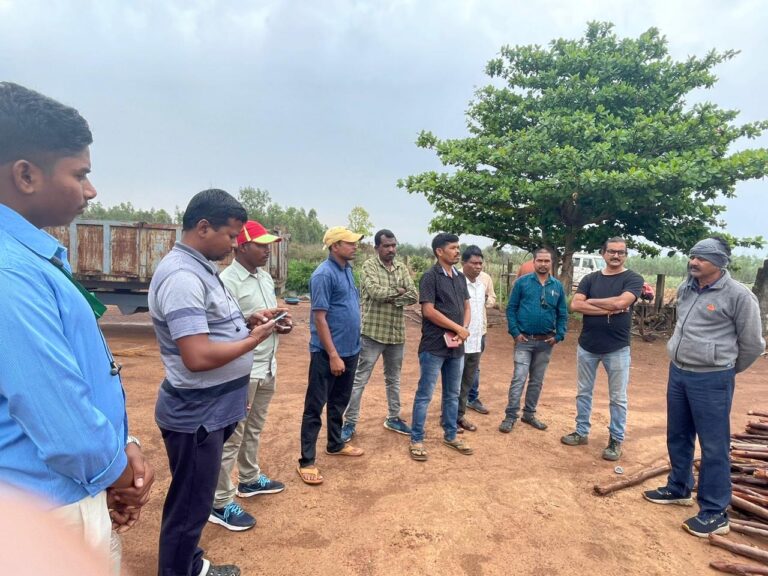A practitioner is one to who a particular framework occurs spontaneously, it seems like second nature. This requires work on intentions, skills, desires, knowledge and developing a community for oneself. This visit helped me see farmer practitioners as a persona! A group of farmer practitioners came together to learn from farmers in Jagdalpur, Bastar, Chattisgarh. This took place on March 18-19, 2023.
The objectives were finalized as:
Detailed objective was
The lead was taken by the farmers – they spent about Rs 7-8,000 per head. These are aspiring farmers who have grown their farming in scale and scope over the last few years. Vriddhi helped with convening support – developing and staying to objectives besides logistics. We also offered financial bursaries for those who were not able to meet their expenses. This helped the group be inclusive and representing at least some of the diversities of the area.

The visit clarified the primary task of an agriculture development program? Primary task, as per group relations frameworks, is something that gives meaning to a system in its context – it is what the system must achieve for it to thrive and continue to have meaning for its context.
A formulation of the task as “Generate experiences that enables farmers to take leadership for their livelihoods and the ecology” builds on a recognition of entrepreneurial spirit of the community and walk the talk on our role as enabling actors and not as protagonists.
Project objectives can be considered as an indication of the task of a project. These would usually have elements of income enhancement, Climate resilient agriculture practices, inclusion of smallholder farmers in value chains among others. These, perhaps unconsciously, put farmers as somewhat passive participants to be motivated, cajoled, nudged, empowered, incentivized into changing their behaviour and benefit from the opportunity created by well-intended development actors.
A development practitioner and a farmer are two different beings. As a development practitioner, many of us are motivated by our desire to bring change, and to be helpful to others. It is important to be aware that one’s development practice is not devoid of one’s own desires and ambition.
Most development workers do not have the lived experience in which to anchor and deepen learning on agriculture and therefore a limitation to the ambition to be learned about farming. Knowledge about farming often also attributes status within the organizations we work in, and so acquisition rather than application may become the unconscious motivation.
The following principles may help in staying the course of not making ourselves our primary task!
Principle 1: Typology of farmers – recognize the diversity and resist temptation to homogenise as one.
Our work in development sector is made possible by simplifying complexity. It may help if one avoids using a broad brush reference to “community” or “Smallholder farmers”. We refer to it as a household, but it contains a world in itself. We can call a smallholder farmer with commercial or market-oriented agriculture a farmer practitioner. Not all smallholder farmers are farmer practitioners. We need to disaggregate the community on this and have a different set of interventions for practitioners, would be practitioners and entrepreneurs.
Principle 2: Build community building not capacity alone
We can recognize that “we stand on the shoulders of giants”. If agriculture is market oriented, then there are other geographies and farmers who have done this before. Studying practices and lessons learnt by them to inform our design and implementation strategy is just the first step.
If we understood the task as we have articulated above, we would strive to establish a learning relationship between these farmers and ‘our target’ farmers. We need to avoid gatekeeping these relationships and encourage interested farmers to continue to exchange notes with each other. The role of the development practitioner in this is to see that there is focus on understand the principles, confidence in sharing own dilemmas and experiences, and not just noting down ‘best practice’. This task would help us keep a wide angle- to build the ability to reflect on oneself and make sense of one’s experience and derive confidence in speaking from one’s own experience.
Principle 3: More diverse and well-supported spaces for reflection and learning Focus on leadership is incomplete without spaces for reflection to learn. Development actors build reflection spaces for our teams. Reflective spaces for farmer practitioners also need to be nurtured. Even better if these are mixed or overlapping ones with farmers and our teams.
Forms and surveys that put the field worker in a complex position of both asking and proving can be avoided with advancements in technology today. Instead technology can be used for tracking the bigger picture – one that can help make wiser choices. It would give us material in the learning community to engage with, to interpret and understand what may be happening?
It is our guestimate that between 20-30% of those who take up precision farming in tribal pockets, drop out after a few years. More monitoring, more drive from the implementer, more funding may not address the core issue. It is time that to see agriculture development not just as a technical or scientific intervention. One that is an intervention in a human system building practitioners and their communities.
This is beyond promoting a farmer collective. It is promoting a community of farmer practitioners.
